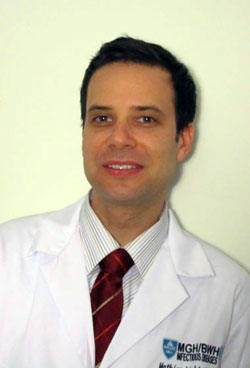The Not-So-Latent Reservoir
By Rowena Johnston, Ph.D.
Research Question
Researchers traditionally refer to the reservoir of HIV that persists despite antiretroviral therapy (ART) as “latent.” This refers to observations suggesting that, while a person takes ART, there is minimal production of new viruses. However, ART does not affect the ability of viruses to produce RNA, an intermediate step to the generation of new viruses. Is it possible that the viral reservoir is not entirely latent, but is actively producing nascent viruses, even if those viruses are prevented from infecting new cells?
Findings

Through a series of technological advances, a team of researchers led by amfAR grantee Dr. Mathias Lichterfeld of Brigham and Women’s Hospital in Boston has developed a method to simultaneously probe the site at which the virus is integrated into the DNA—whether or not it is genetically intact—and its production of RNA. They used their new assay, called PRIP-seq, to characterize the reservoirs of six people with HIV (PWH) on long-term ART.
Despite the strong preference of HIV to integrate into active gene regions of DNA, the researchers found that 17% of integrated viruses were in non-genic regions. These viruses produced substantially less RNA than viruses integrated into gene-rich regions of DNA. Where blood samples were available over at least nine years during the course of ART, the researchers noted that the frequency of viruses that produce RNA decreased over time.
This loss of RNA-producing viruses was more pronounced in viruses that were genetically intact, leading to a reservoir composed increasingly of a combination of defective proviruses and intact proviruses that did not produce RNA. However, this can be counter-balanced by the emergence of clones of virus, whereby one infected cell generates multiple copies of itself and the virus it harbors, and these multiple copies of the same virus can, in rare cases, produce RNA.
Impact
The authors concluded that rather than being stable or “latent,” the immune system may continuously detect and eliminate reservoir cells that produce RNA—even in people taking ART—and that these forces may result in an increasingly defective collection of viruses that hide in regions of DNA from which they cannot emerge. While clones of intact viruses can counteract these forces, they are exceptions to the rule. Future studies using this new technique developed by Dr. Lichterfeld and colleagues may shed light on whether latency-reversing agents—the shock component of the shock-and-kill approach to curing HIV—may actually speed this process.amfAR’s Role
amfAR was a funder of this research.
Original Article
https://pubmed.ncbi.nlm.nih.gov/35026153/
Dr. Johnston is amfAR vice president and director of research.
Share This:
